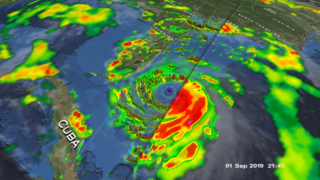Earth
ID: 4753
GPM captured Dorian at 10:41 UTC (6:41 am EDT) on the 4th of September when the storm was moving north-northwest parallel to the coast of Florida about 90 miles due east of Daytona Beach. Three days earlier, Dorian had struck the northern Bahamas as one of the most powerful Category 5 hurricanes on record in the Atlantic with sustained winds of 185 mph. Weakening steering currents allowed the powerful storm to ravage the northern Bahamas for 2 full days. During this time, Dorian began to weaken due to its interactions with the islands as well as the upwelling of cooler ocean waters from having remained in the same location for so long. Immediately apparent is Dorian’s well-defined but very large eye. This feature is often seen in the later stages of powerful tropical cyclones, which includes hurricanes and typhoons. As these mature, powerful storms age, their wind field tends to expand. They often undergo what is known as eye wall replacement cycles wherein a 2nd concentric eye wall forms outside of the original inner eye wall. The inner eye wall is choked off and weakens leaving the outer eye wall as the dominant eye wall. The outer eye wall can still contract, but often the storm is left with a larger eye as is the case with Dorian. At the time of this image, Dorian’s maximum sustained winds were still 105 mph, making it a Category 2 storm, but a very large Category 2 storm.
GPM data is archived at https://pps.gsfc.nasa.gov/


GPM observes Hurricane Dorian lashing Florida
GPM data is archived at https://pps.gsfc.nasa.gov/


Related
Visualization Credits
Alex Kekesi (Global Science and Technology, Inc.): Lead Data Visualizer
Greg Shirah (NASA/GSFC): Data Visualizer
Kel Elkins (USRA): Data Visualizer
George Huffman (NASA/GSFC): Lead Scientist
Dalia B Kirschbaum (NASA/GSFC): Lead Scientist
Gail Skofronick Jackson (NASA/GSFC): Lead Scientist
Scott Braun (NASA/GSFC): Lead Scientist
Stephen Lang (SSAI): Writer
Ryan Fitzgibbons (USRA): Lead Producer
Greg Shirah (NASA/GSFC): Data Visualizer
Kel Elkins (USRA): Data Visualizer
George Huffman (NASA/GSFC): Lead Scientist
Dalia B Kirschbaum (NASA/GSFC): Lead Scientist
Gail Skofronick Jackson (NASA/GSFC): Lead Scientist
Scott Braun (NASA/GSFC): Lead Scientist
Stephen Lang (SSAI): Writer
Ryan Fitzgibbons (USRA): Lead Producer
Please give credit for this item to:
NASA's Scientific Visualization Studio
NASA's Scientific Visualization Studio
Short URL to share this page:
https://svs.gsfc.nasa.gov/4753
Mission:
Global Precipitation Measurement (GPM)
Data Used:
Note: While we identify the data sets used in these visualizations, we do not store any further details nor the data sets themselves on our site.
This item is part of these series:
Flooding
Floods
GPM Animations
Keywords:
DLESE >> Atmospheric science
DLESE >> Hydrology
DLESE >> Natural hazards
GCMD >> Earth Science >> Atmosphere >> Precipitation >> Rain
GCMD >> Earth Science >> Hydrosphere >> Surface Water >> Floods
SVS >> Hyperwall
NASA Science >> Earth
GCMD >> Earth Science >> Human Dimensions >> Natural Hazards >> Floods
GCMD >> Earth Science >> Terrestrial Hydrosphere >> Surface Water >> Floods
NASA Earth Science Focus Areas >> Weather and Atmospheric Dynamics
GCMD keywords can be found on the Internet with the following citation: Olsen, L.M., G. Major, K. Shein, J. Scialdone, S. Ritz, T. Stevens, M. Morahan, A. Aleman, R. Vogel, S. Leicester, H. Weir, M. Meaux, S. Grebas, C.Solomon, M. Holland, T. Northcutt, R. A. Restrepo, R. Bilodeau, 2013. NASA/Global Change Master Directory (GCMD) Earth Science Keywords. Version 8.0.0.0.0
https://svs.gsfc.nasa.gov/4753
Mission:
Global Precipitation Measurement (GPM)
Data Used:
GPM/GMI/Surface Precipitation also referred to as: Rain Rates
9/4/2019
Credit:
Data provided by the joint NASA/JAXA GPM mission.
Data provided by the joint NASA/JAXA GPM mission.
GPM/DPR/Ku also referred to as: Volumetric Precipitation data
Observed Data - JAXA - 9/4/2019
Credit:
Data provided by the joint NASA/JAXA GPM mission.
Data provided by the joint NASA/JAXA GPM mission.
also referred to as: IMERG
Data Compilation - NASA/GSFC - 9/3/2019 - 9/4/2019This item is part of these series:
Flooding
Floods
GPM Animations
Keywords:
DLESE >> Atmospheric science
DLESE >> Hydrology
DLESE >> Natural hazards
GCMD >> Earth Science >> Atmosphere >> Precipitation >> Rain
GCMD >> Earth Science >> Hydrosphere >> Surface Water >> Floods
SVS >> Hyperwall
NASA Science >> Earth
GCMD >> Earth Science >> Human Dimensions >> Natural Hazards >> Floods
GCMD >> Earth Science >> Terrestrial Hydrosphere >> Surface Water >> Floods
NASA Earth Science Focus Areas >> Weather and Atmospheric Dynamics
GCMD keywords can be found on the Internet with the following citation: Olsen, L.M., G. Major, K. Shein, J. Scialdone, S. Ritz, T. Stevens, M. Morahan, A. Aleman, R. Vogel, S. Leicester, H. Weir, M. Meaux, S. Grebas, C.Solomon, M. Holland, T. Northcutt, R. A. Restrepo, R. Bilodeau, 2013. NASA/Global Change Master Directory (GCMD) Earth Science Keywords. Version 8.0.0.0.0












